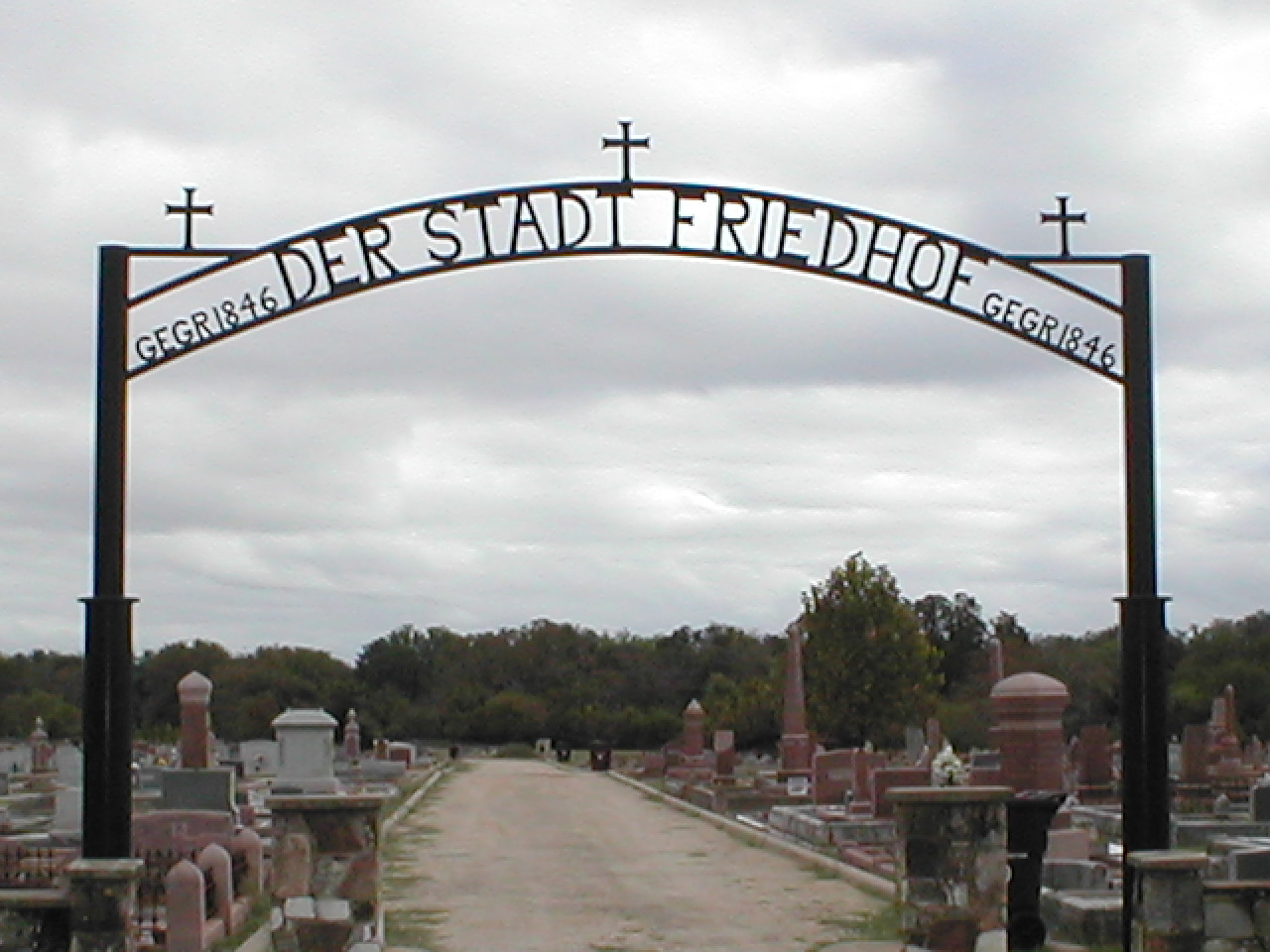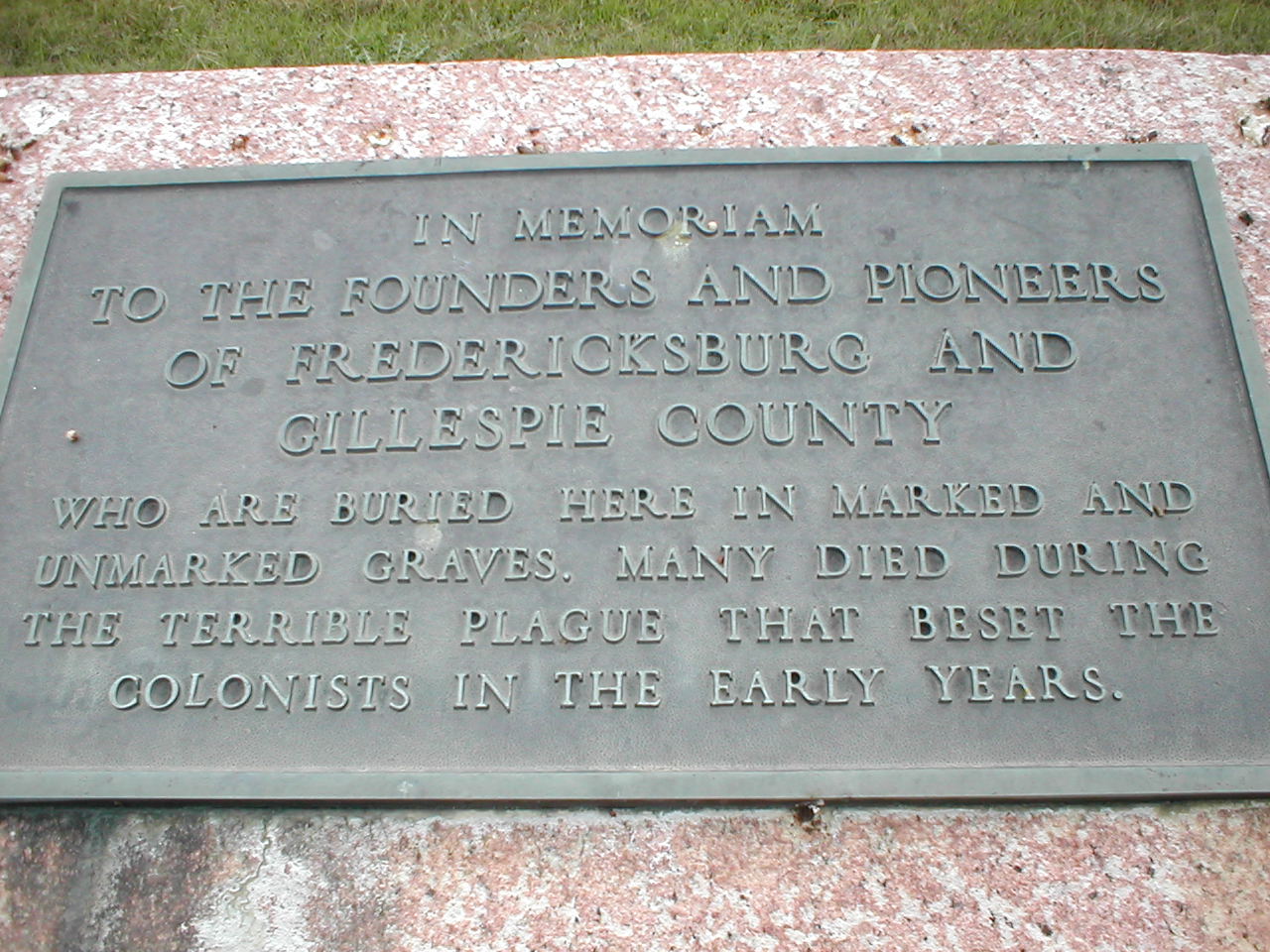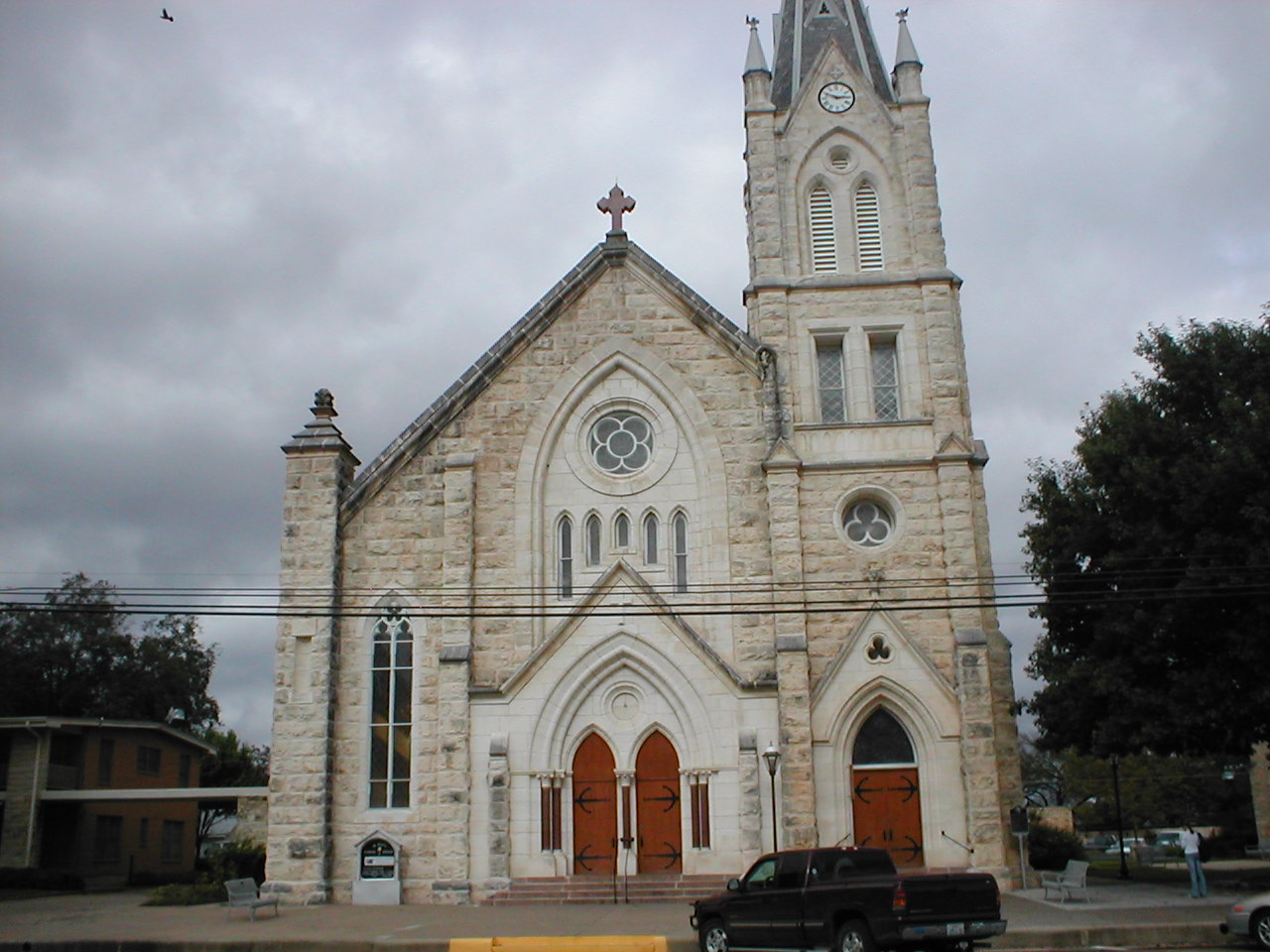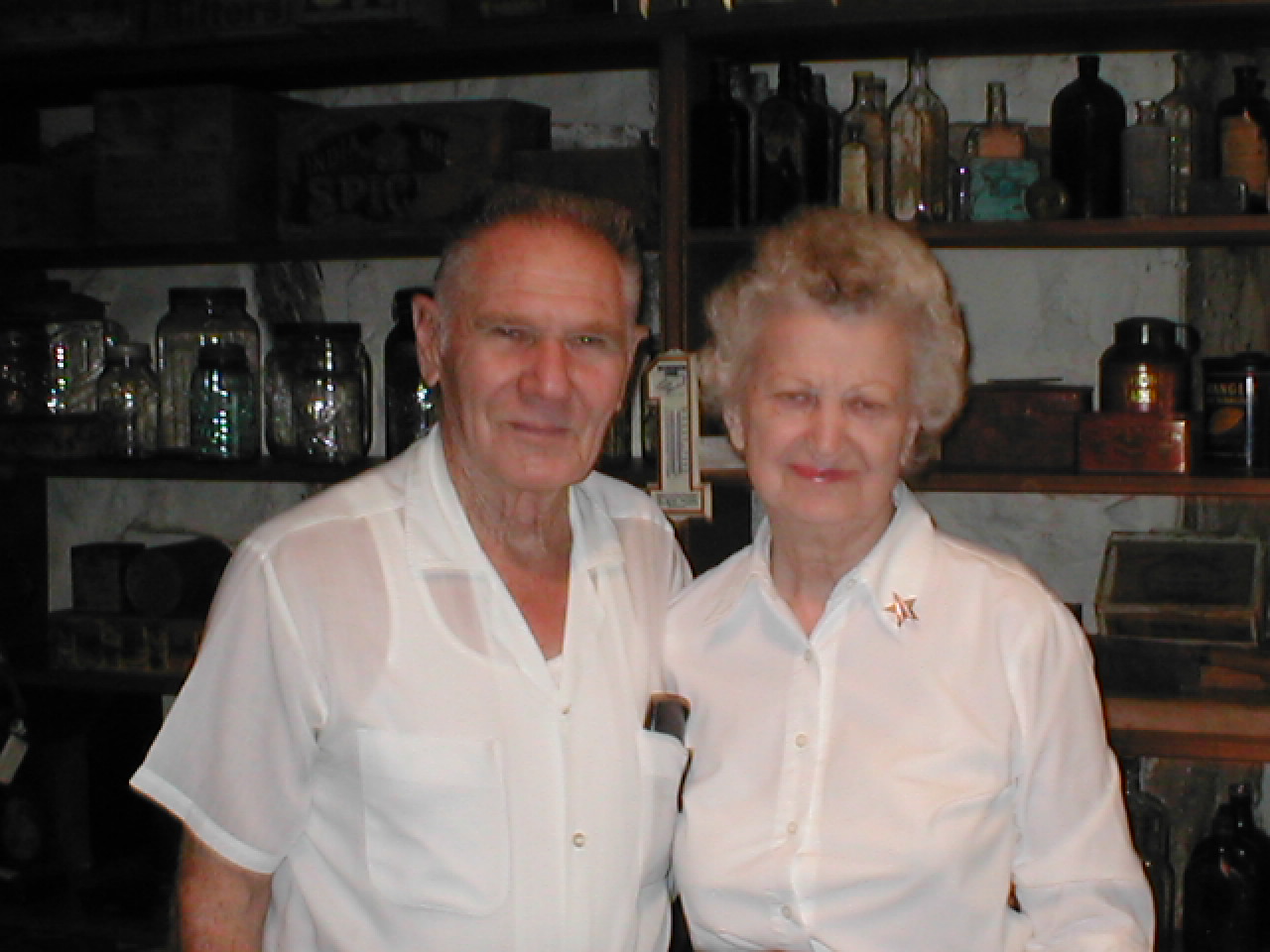| Marissa Komatz & Reuben Ramirez | Fall 2002 |
| History 1302 | Hines |
Interviews with Mr. Clinton Stork & Mrs. Evelyn Stork
ORIGINS:
On May 8,1846 the town of Fredericksburg was founded by 120 German settlers. The settlers were led by a man named John Meusebach, who worked for the Society for the Protection of German Immigrants in Texas (Adels Verein) as the Commissioner General. He chose the name Fredericksburg to honor Prince Frederick of Prussia. The settlers were given several plots of land depending on their marital status. All of the settlers were allotted a half-acre in town, and 10 acres around the town. Single men were also given 160 acres in the country, and married men were given 320 acres in the country. All of this land was free from the Society, and by 1848 about 600 settlers had begun to cultivate this land for farming. In order for the settling of Fredericksburg to be successful, the Germans had to come to an agreement with the Comanche. The Indians agreed to let the settlers farm the land along the Pedernales River, and the settlers agreed that the Indians would always be welcome in the town. The settlers also agreed to help the Comanche during times of hunger by providing the Indians with grain, and other necessities in exchange for meat, honey, and bear fat. The Comanche also asked that one settler live with them, and the man chosen for this was Emil Kriewitz. He would marry the daughter of the chief, and later become chief himself after his father-in-law died. The “Meusebach Peace Treaty” is the only treaty made between white men, and Indians that was never broken by either side.
THE FIRST YEARS IN FREDERICKSBURG:
The first few years in Fredericksburg were very difficult for the new settlers. The first winter was very wet, and the great number of mosquitoes spread malaria. There were no doctors or hospitals closer than New Braunfels. The settlers also arrived in Fredericksburg too late in the year to plant crops. This hardship was eased by the wild fruit growing abundantly around the settlement, and by trading with the Indians for necessities. In the summer and fall of 1846, cholera killed a great number of settlers, and then struck the town again in 1849. This epidemic was the most devastating in the history of the town. The death toll was so high that survivors could not keep up with making coffins, and instead wrapped their family members in sailcloth to be buried. Many of the dead lie in unmarked graves in the Stadt-Friedhof, which is the old part of the city cemetery. The unknown dead were honored in a ceremony in 1946, during the centennial celebration, with a memorial marker. After the two years, the settlers began planting crops such as corn, wheat, and oats. They also started cattle ranching. Fredericksburg was the last place for travelers to get supplies until El Paso, and therefore merchants did well, especially in 1849 during the California Gold Rush. In 1847, Fredericksburg was made a precinct of Bexar county, and in December the townspeople petitioned to create Gillespie County with Fredericksburg as the county seat. Their petition was granted in 1848, and they began electing their first officials. Another important alliance that was made in the early years was with the Mormon Colony known as Zodiac. The Mormons found the people of the town dying of cholera, and starving to death. The Mormons rushed to help the people of Fredericksburg, and the two communities developed a deep respect for each other. This Mormon community does not exist today, but the kindness they offered the settlers in their early years is one of the most important
reasons that the colony survived to become the town it is today.


FREDERICKSBURG AND THE MILITARY:
Though the peace treaty was never broken between the townspeople and the Indians, the relationship was strained at times. This strain was because the Indians resented the colonization of the white men in the area. There were several attacks by renegade Indians, but the tribe never declared war with the settlers. The United States government decided to build a fort near Fredericksburg in order to protect the settlers. The fort was called Fort Martin Scott, and it was two and a half miles south of town. There is no recorded history of any skirmishes between the soldiers and the Indians. However, there are many cases of the soldiers causing problems with the townspeople. For instance, there is a story of a soldier that was refused service at a saloon because he was already extremely intoxicated. He caused a fight, and was killed by the bar owner. The next day, other soldiers came to town to avenge the killing. They burned down the store, and saloon. The building was the site where all of Fredericksburg’s documents were stored because the town was only three years old, and all of the records for the town’s first three years was lost. The fort was closed in 1852 because there was never any trouble with the Comanche. In 1986, the Fredericksburg Heritage Federation decided to restore the fort to its original condition.
SOURCES OF REVENUE-PAST AND PRESENT:
When the German settlers first arrived in Fredericksburg there were very few sources of income. A few of the settlers were blacksmiths, and farmers in Germany, but there was little use for these jobs at first. The settlers were mostly trying to survive for the first couple of years. During the third year, the settlers began farming in larger quantities, and even ranching. The farmers planted corn, wheat, and even cotton until the boll weevil killed the crops. The ranchers were mostly involved with cattle. There were other people raising animals such as hogs and turkeys. The need for revenue was not as necessary in the past because the settlers traded with the Indians for anything they could not grow or raise for themselves. Today, the main source of revenue is the tourist trade. Virtually everyone in the town is involved in the tourist business, this includes shops, restaurants, museums, and the bed-and-breakfasts. The town attracts so many tourists because of its small town atmosphere, and big city shopping. Fredericksburg gets up to 30,000 visitors every weekend of the year from all over the world. There are still a few farmers and ranchers, but they move farther away from the town, as it grows more commercial. This is an accepted way of life, but some do wish for the quieter way life used to be before the tourists came.
PRESERVING FREDERICKSBURG:
It has always been a goal for local people in Fredericksburg to preserve the small town, German atmosphere of their town. This includes maintaining the historic sites, and buildings in the town. Storeowners have to get approval from the City Council-appointed Historic Review Board before they can change their buildings. Tourists began really seeking out Fredericksburg after Lyndon B. Johnson introduced people to all that the town had to offer. A local architect, Albert Keidel, is credited with realizing that the structures in Fredericksburg were worth preserving. The buildings that line Main Street in Fredericksburg are mostly historic sites, such as the original hospital. The people of Fredericksburg are determined that their town not become another Schlitterbahn or Branson. This way of life is emphasized in all the zoning laws, and steps that storeowners are required to go through in order to change any part of the town. This quaint town has intends to remain that way.

WILL FREDERICKSBURG SURVIVE? :
There is no doubt that this town will survive through the test of time. Fredericksburg offers tourists the atmosphere of a small town with the attractions of a much larger city. This combined with the climate that agrees with almost everyone will ensure that people continue making the trek to this town. The economy of Fredericksburg will continue to grow, and expand the boundaries of the town. Many of the local people believe that Fredericksburg will soon attract the big universities of Texas, and that the town will become a college town in upcoming years. This town is definitely going to survive for a very long time, and has a very bright future ahead.
Interview with Mr. Clinton Stork & Mrs. Evelyn Stork
(German Interpreters employed by Gillespie County Historical Society at the Pioneer Museum in Fredericksburg, TX)
Interviewed on October 27, 2002:

Q: Where did your families come from in Germany?
A: They came to the United States from Koblenz, Germany in 1845.
Q: When did your families settle in Fredericksburg?
A: Our families were two of the original settling families here. They arrived in Fredericksburg on May 8th, 1846.
Q: Approximately, how much did the Germans pay for Fredericksburg?
A: This amount is not written anywhere, but it is said that they got the 10,000 acres that would become Fredericksburg on credit.
Q: What did the original settlers do when they arrived in Fredericksburg? (I.e. food, occupations)
A: Many of the settlers were farmers, and blacksmiths from Germany. They did not have jobs when they first arrived because there was not a town. Everything they did for the first two years was for survival. Once the town was more developed the settlers were farmers, teamsters, wagoneers, and masons. When they arrived it was too late in the year to plant a crop, so they caught rabbits and fish for food. The next year the farmers planted corn, wheat, and small vegetable gardens for their families. There were not any real crops until 1848. They also ate the fruit that grew around the town, like wild plums, apples, and peaches. The settlers also traded extensively with the Indians. The relationship between the Indians, and the German settlers in this area was very important for both sides. Both groups helped out the other with food, and supplies whenever anything could be spared. The peace treaty between the two groups is the only treaty that was never broken.
Q: What were the main sources of revenue for Fredericksburg in the past?
A: The people of Fredericksburg were mainly farmers in the past. They raised corn, wheat, oats, and briefly cotton. They also became ranchers, and raised many cattle. A few people caught, raised, and sold turkeys from the wild. Some people raised, and sold hogs for their living. However, the family, for survival, kept much of what was grown and/or raised. There was not much need for revenue because of the trading with the Indians.
Q: What are the main sources of revenue for people in Fredericksburg now?
A: Today, the town is mainly kept going by tourist trade. This is the biggest source of revenue for local people. This includes shops, restaurants, museums, and the bed-and –breakfasts. This town gets approximately 15,000-30,000 visitors every weekend, and this number goes up during holidays. People come here for the climate, and atmosphere. Fredericksburg is 2000 feet above sea level, so the weather is milder, and much less humid. The small town atmosphere draws people from all over the world. There are also still farmers and ranchers around town. They raise corn, and peaches for their main crops. The ranchers raise cattle, but the ranches are slowly moving away from this area as it becomes more commercial.
Q: How has the town changed from your childhood to present day?
A: (Clinton) I believe that the town has changed for the worse. The crime rate has gone up, as more outsiders move here. They move here to get away from crime, and end up bringing it along with them. When I was a child no one locked his or her doors, and everyone knew everyone else. There were also a lot of community events like dances every Saturday night, and almost every local business had a baseball team. People were lucky if they got to get all the way through high school, and now everyone goes to school, and then to college. Everything was so much cheaper in those days. You didn’t pay $5.00 for a hamburger instead you paid $ .15. I do not think this town has gotten better during the years. I wish things could be the way they were when I was a kid.
A: (Evelyn) There have been many changes since I was a child. I see many of the changes just as my husband, but I do not think they are all bad. Even though the crime rate is higher than when we were young, I think the new people, and tourists are necessary for the survival of our town. It is part of life that a town must change in order to survive.
Q: What do you see in the future for Fredericksburg?
A: The town will continue to grow in order to accommodate the tourists. More businesses, restaurants, and hotels will be built to accommodate all of the tourists. Hopefully, the growth does not change the small town atmosphere. Schooling will also become more important, and the town will someday be a college town. Colleges will want to build their campuses here for all of the young people, and then even more people will come here to live. There is always the increase of retirees coming here to live, and we already have six-eight assisted living homes here in Fredericksburg. That number will increase as older people move here to get out of the big cities. The town will continue to thrive, and get bigger.
ANNOTATED BIBLIOGRAPHY:
Fredericksburg…A Glimpse of the Past From Logs to Sunday Houses. Published by The Vereins Kirche Archives Committee. 1981. The guides at the Pioneer Museum in Fredericksburg recommended this pamphlet. It was very informative, and gave a good history of the town.
Edwards, Walter F. Fredericksburg Guidebook. 1994. This book was the most helpful book for getting the history and origins of Fredericksburg. We bought this book in Fredericksburg, and it was a really good source.
Geil, Holley & Kevin. “Saving the Soul of Fredericksburg: Hill Country’s Capital of Quaint Trying to Hold onto Its German Heritage”. San Antonio Express News. 2000. This source was more about how the town came to be preserved than about the history of Fredericksburg. The reading was interesting though.
Zelade, Richard. Hill Country. 1987. This source was not much use, or very interesting. It is very dull, and outdated.
Rafferty, Richard. Texas: Completely Revised 3rd Edition. 1989. This book was also a repeat of the previous source. The information was just repeated, and was outdated.
Lich, Glen E. The German Texans. 1996. This source was very vague, but it did have some very interesting stories, and customs that the German settlers brought with them.
Driskill, Frank A. & Casad, Dede W. Admiral of the Hills. 1983. This source was strictly about Admiral Nimitz, and had no use for this paper.
Kohout, Martin Donell. The Handbook of Texas Online. “Fredericksburg, TX”. 2002. This source just had the very basic facts about Fredericksburg. It did not go into any depth at all. It was helpful with getting the basics down about the town and its settlers.
Interview with Clinton Stork. October 27, 2002. Mr. Stork was a wonderful person to interview. He was very informative, and he was more than happy to tell us all he knew about Fredericksburg. His knowledge of the town is better than any book because his family was one of the original settling families in Fredericksburg. He knew a great deal about the lives of the original settlers that the books do not have in them. He answered every question we asked, and also supplied information that we would not have even thought to ask about. He was by far the best source for our research.
Interview with Evelyn Stork. October 27, 2002. This is the wife of Mr. Clinton Stork. She was also very informative, and finished many of the stories Mr. Stork started. She was also more than happy to answer our questions, and to elaborate on the stories her husband told. Her family was also on of the original settling families. She and her husband were very valuable sources.